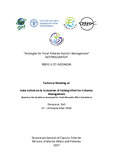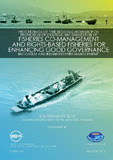| dc.contributor.author | Umi Muawanah, PhD. | |
| dc.date.accessioned | 2019-10-18T07:28:38Z | |
| dc.date.available | 2019-10-18T07:28:38Z | |
| dc.date.issued | 2016 | |
| dc.identifier.citation | Umi , M. (2016). Guideline For Fishing Effort Management (Total Allowable Effort) In Trawl Fishery Management In Aru and Arafura Sea in Strategies for trawl fisheries bycatch management project | |
| dc.identifier.uri | http://hdl.handle.net/20.500.12067/992 | |
| dc.description | This document is one of the three “guidelines” describing the Mapping, Gear Selection and Total Allowable Effort (MGT) management approaches produced at the REBYC-II CTI project. This document provides information regarding background, scope, goals of the literature, theory and models of Total Allowable Effort (TAE) management approach and provisional estimation of technical capacity and Total Allowable Effort in Aru and Arafura Sea industrial fishery.
Firstly, the document explains the process of consultation and setting up the goals, and the methods and data shared with the National Working Group of REBYC-CTI project. This consultation was a participatory process with the stakeholders of Aru and Arafura Sea fishery. The goal of this “guideline” is to act as a tool for assessing the current fishing capacity and estimating if there is over or under capacity in the Aru and Arafura fishery. The guideline also provides a method for estimating the optimal target capacity.
The document then explains key concepts of capacity assessment in fishery. Those concepts include capacity output, capacity utilization and excess capacity. The document provides explanation what are the potential consequences from various capacity conditions. It then explains the theory of accessing the fishing capacity, i.e., the overall technical efficiency of the fishing vessels. Once the policy makers understand the existing technical efficiency of the existing fishing vessels, it would be possible to estimate what is the target capacity and the potential ways of Capacity Reduction Program (CRP). Theory for estimating the technical efficiency uses the output-oriented measures namely the simple CPUE calculation and Stochastic Frontier Analysis (SFA). The theoretical background to assess or determine the target capacity are based on the Maximum Sustainable Yield (MSY) and Maximum Economic Yield (MEY).
Each method has limitation despite the ability to assess the technical and target capacity. The simple CPUE approach only needs data of days at sea and catch of the vessels or catch of the fleet for certain period (e.g. yearly catch). It does not count other factors impacting vessels productivity such as technology and human skills. The SFA method incorporates also those variables. However, the data are not always available from the industries or government offices. The MSY approach is well known and widely adopted approach. The data needed for the analysis is usually available although sometimes is not available as a time series. The MEY approach is harder to use since it needs the price of the fish products and total cost of the fishing efforts. The strength of MEY is that it provides sort of low boundary for Total Allowable Effort.
This document uses a data set of nine to eleven vessels that operated between years 2000 and 2010 in the study region to estimate the technical efficiency and the total allowable efforts from stakeholders, namely fishing industries and associations in Aru and Arafura Seas. The longer time series data were also used for estimating the TAE.
Main outcome was that the technical efficiency of those vessels operating in Aru and Arafura Sea ranged between 0.6-0.97 when using simple CPUE comparison and between 0.78-0.96 when using SFA. The sustainable TAE (MSY) for Banana Shrimp Fishery is far higher than the existing overall effort in that fishery. However, the sustainable TAE for Tiger Shrimp is almost at the same level as the overall effort in the most recent year of this study. Hence, based on the data that we used in this document, the shrimp trawl fishery did not exhibit excess capacity, i.e. the capacity was in balance for target stocks and their production levels.
In conclusion, due to the fact that the shrimp fishery did not exhibit overcapacity in Aru and Arafura Sea in 2000-2010, this study suggests that maintaining the fishing licenses deployed in Aru and Arafura Sea at the same level would allow sustainable harvest. Constant monitoring the status of the resources and fishing effort is necessary to maintain the exploitation at sustainable level. | en |
| dc.description.abstract | Trawl fishery in Indonesia is considered to have negative impact on the fisheries resources and it is also considered to be destructive to the marine ecosystems and impact negatively on the biodiversity, threatening sustainability of fisheries affecting livelihoods and opportunities also decreasing the food security. Furthermore, this fishing technology creates significant bycatch and jeopardizes the benthic habitats by using heavy otter board, tickler chains and bobbins that are dragged along the seabed. The intensive utilization of trawls is considered have been impacting the environmental and habitat condition, as well as contributed the decline in fisheries resources (overfishing).
Aru and Arafura Sea are known to have high potential in shrimp and demersal fish resources because of the characteristics of its ecosystem, such as muddy or sandy mud substrate, large mangrove coverage, and sloping sea bed contour. Currently, the fishing gear practices that exploit the shrimp resources are trawlers. MMAF prohibits trawlers under the Ministerial Decree no 56 year 2014 and the trawl ban is effective from December 2015.
FAO coordinated the global REBYC-I project (Reduction of Environmental Impact from Tropical Shrimp Trawling through the Introduction of Bycatch Reduction Technologies and Change of Management) in 2002-2008. The project focused mainly to the development and testing of technology for reducing the by catch and improving technical management of industrial shrimp fisheries in tropical countries. The regional follow-up project, REBYC-II CTI (2012-2016), has taken a wider approach in the management of bycatch and other impacts of trawl fishing.
Through REBYC-I it was demonstrated that the installation of Bycatch Reduction Devices (BRDs) on trawl vessels, including Turtle Excluder Device (TED) and Juvenile and Trash Fish Excluder Device (JTED) can help to reduce bycatch in places like Sorong, Merauke, Ambon, Tual, Sibolga and Tarakan. | en |
| dc.language.iso | en | en |
| dc.publisher | SEAFDEC | en |
| dc.subject | fishing effort | en |
| dc.subject | Fisheries Management | |
| dc.subject | Trawl Fisheries | |
| dc.subject | REBYC II CTI | |
| dc.subject | Mapping Gear | |
| dc.title | Guideline For Fishing Effort Management (Total Allowable Effort) In Trawl Fishery Management In Aru and Arafura Sea | en |
| dc.type | Technical Report | en |




